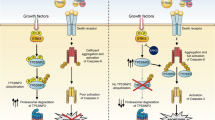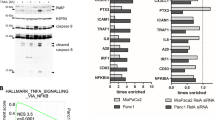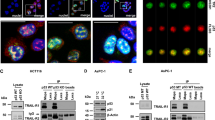Abstract
Tumor necrosis factor-related apoptosis-inducing ligand (TRAIL) induces apoptosis through its cognate receptors death receptor 4 (DR4) and death receptor 5 (DR5), preferentially in malignant cells. However, many malignant cells remain resistant to TRAIL cytotoxicity by poorly characterized mechanisms. Here, using cholangiocarcinoma cells, as a model for TRAIL resistance, we identified a role for the oncogenic Hedgehog (Hh)-GLI pathway in the regulation of TRAIL cytotoxicity. Blockade of Hh using pharmacological and genetic tools sensitizes the cells to TRAIL cytotoxicity. Restoration of apoptosis sensitivity coincided with upregulation of DR4 expression, while expression of other death effector proteins remained unaltered. Knockdown of DR4 mimics Hh-mediated resistance to TRAIL cytotoxicity. Hh regulates the expression of DR4 by modulating the activity of its promoter. Luciferase, chromatin immunoprecipitation and expression assays show that the transcription factor GLI3 binds to the DR4 promoter and Hh requires an intact GLI3-repression activity to silence DR4 expression. Finally, small interfering RNA (siRNA)-targeted knockdown of GLI3, but not GLI1 or GLI2, restores DR4 expression and TRAIL sensitivity, indicating that the Hh effect is exclusively mediated by this transcription factor. In conclusion, these data provide evidence of a regulatory mechanism, which modulates TRAIL signaling in cancer cells and suggest new therapeutic approaches for TRAIL-resistant neoplasms.
This is a preview of subscription content, access via your institution
Access options
Subscribe to this journal
Receive 50 print issues and online access
$259.00 per year
only $5.18 per issue
Buy this article
- Purchase on Springer Link
- Instant access to full article PDF
Prices may be subject to local taxes which are calculated during checkout






Similar content being viewed by others
Accession codes
References
Akazawa Y, Mott JL, Bronk SF, Werneburg NW, Kahraman A, Guicciardi ME et al. (2009). Death receptor 5 internalization is required for lysosomal permeabilization by TRAIL in malignant liver cell lines. Gastroenterology 136: 2365–2376 e2361-2367.
Ashkenazi A, Dixit VM . (1999). Apoptosis control by death and decoy receptors. Curr Opin Cell Biol 11: 255–260.
Berman DM, Karhadkar SS, Maitra A, Montes De Oca R, Gerstenblith MR, Briggs K et al. (2003). Widespread requirement for Hedgehog ligand stimulation in growth of digestive tract tumours. Nature 425: 846–851.
Bigelow RL, Chari NS, Unden AB, Spurgers KB, Lee S, Roop DR et al. (2004). Transcriptional regulation of bcl-2 mediated by the sonic hedgehog signaling pathway through gli-1. J Biol Chem 279: 1197–1205.
Chen JK, Taipale J, Cooper MK, Beachy PA . (2002). Inhibition of Hedgehog signaling by direct binding of cyclopamine to Smoothened. Genes Dev 16: 2743–2748.
Chen MH, Wilson CW, Li YJ, Law KK, Lu CS, Gacayan R et al. (2009). Cilium-independent regulation of Gli protein function by Sufu in Hedgehog signaling is evolutionarily conserved. Genes Dev 23: 1910–1928.
Daniel PT, Wieder T, Sturm I, Schulze-Osthoff K . (2001). The kiss of death: promises and failures of death receptors and ligands in cancer therapy. Leukemia 15: 1022–1032.
Eggert A, Grotzer MA, Zuzak TJ, Wiewrodt BR, Ho R, Ikegaki N et al. (2001). Resistance to tumor necrosis factor-related apoptosis-inducing ligand (TRAIL)-induced apoptosis in neuroblastoma cells correlates with a loss of caspase-8 expression. Cancer Res 61: 1314–1319.
Falschlehner C, Emmerich CH, Gerlach B, Walczak H . (2007). TRAIL signalling: decisions between life and death. Int J Biochem Cell Biol 39: 1462–1475.
Guan B, Yue P, Clayman GL, Sun SY . (2001). Evidence that the death receptor DR4 is a DNA damage-inducible, p53-regulated gene. J Cell Physiol 188: 98–105.
Guan B, Yue P, Lotan R, Sun SY . (2002). Evidence that the human death receptor 4 is regulated by activator protein 1. Oncogene 21: 3121–3129.
Higuchi H, Bronk SF, Takikawa Y, Werneburg N, Takimoto R, El-Deiry W et al. (2001). The bile acid glycochenodeoxycholate induces trail-receptor 2/DR5 expression and apoptosis. J Biol Chem 276: 38610–38618.
Ishimura N, Isomoto H, Bronk SF, Gores GJ . (2006). Trail induces cell migration and invasion in apoptosis-resistant cholangiocarcinoma cells. Am J Physiol Gastrointest Liver Physiol 290: G129–G136.
Isomoto H, Mott JL, Kobayashi S, Werneburg NW, Bronk SF, Haan S et al. (2007). Sustained IL-6/STAT-3 signaling in cholangiocarcinoma cells due to SOCS-3 epigenetic silencing. Gastroenterology 132: 384–396.
Johnstone RW, Frew AJ, Smyth MJ . (2008). The TRAIL apoptotic pathway in cancer onset, progression and therapy. Nat Rev Cancer 8: 782–798.
Kischkel FC, Hellbardt S, Behrmann I, Germer M, Pawlita M, Krammer PH et al. (1995). Cytotoxicity-dependent APO-1 (Fas/CD95)-associated proteins form a death-inducing signaling complex (DISC) with the receptor. EMBO J 14: 5579–5588.
Kluck RM, Bossy-Wetzel E, Green DR, Newmeyer DD . (1997). The release of cytochrome c from mitochondria: a primary site for Bcl-2 regulation of apoptosis. Science 275: 1132–1136.
Kobayashi S, Werneburg NW, Bronk SF, Kaufmann SH, Gores GJ . (2005). Interleukin-6 contributes to Mcl-1 up-regulation and TRAIL resistance via an Akt-signaling pathway in cholangiocarcinoma cells. Gastroenterology 128: 2054–2065.
Kump E, Ji J, Wernli M, Hausermann P, Erb P . (2008). Gli2 upregulates cFlip and renders basal cell carcinoma cells resistant to death ligand-mediated apoptosis. Oncogene 27: 3856–3864.
Lees C, Howie S, Sartor RB, Satsangi J . (2005). The hedgehog signalling pathway in the gastrointestinal tract: implications for development, homeostasis, and disease. Gastroenterology 129: 1696–1710.
Liu X, Kim CN, Yang J, Jemmerson R, Wang X . (1996). Induction of apoptotic program in cell-free extracts: requirement for dATP and cytochrome c. Cell 86: 147–157.
Mendoza FJ, Ishdorj G, Hu X, Gibson SB . (2008). Death receptor-4 (DR4) expression is regulated by transcription factor NF-kappaB in response to etoposide treatment. Apoptosis 13: 756–770.
Mott JL, Kobayashi S, Bronk SF, Gores GJ . (2007). mir-29 regulates Mcl-1 protein expression and apoptosis. Oncogene 26: 6133–6140.
Parkin CA, Ingham PW . (2008). The adventures of Sonic Hedgehog in development and repair. I. Hedgehog signaling in gastrointestinal development and disease. Am J Physiol Gastrointest Liver Physiol 294: G363–G367.
Regl G, Kasper M, Schnidar H, Eichberger T, Neill GW, Philpott MP et al. (2004). Activation of the BCL2 promoter in response to Hedgehog/GLI signal transduction is predominantly mediated by GLI2. Cancer Res 64: 7724–7731.
Rubin LL, de Sauvage FJ . (2006). Targeting the Hedgehog pathway in cancer. Nat Rev Drug Discov 5: 1026–1033.
Rudin CM, Hann CL, Laterra J, Yauch RL, Callahan CA, Fu L et al. (2009). Treatment of Medulloblastoma with Hedgehog Pathway Inhibitor GDC-0449. N Engl J Med 361: 1173–1178.
Sasaki H, Hui C, Nakafuku M, Kondoh H . (1997). A binding site for Gli proteins is essential for HNF-3beta floor plate enhancer activity in transgenics and can respond to Shh in vitro. Development 124: 1313–1322.
Taipale J, Chen JK, Cooper MK, Wang B, Mann RK, Milenkovic L et al. (2000). Effects of oncogenic mutations in Smoothened and Patched can be reversed by cyclopamine. Nature 406: 1005–1009.
Taniai M, Grambihler A, Higuchi H, Werneburg N, Bronk SF, Farrugia DJ et al. (2004). Mcl-1 mediates tumor necrosis factor-related apoptosis-inducing ligand resistance in human cholangiocarcinoma cells. Cancer Res 64: 3517–3524.
Wagner KW, Punnoose EA, Januario T, Lawrence DA, Pitti RM, Lancaster K et al. (2007). Death-receptor O-glycosylation controls tumor-cell sensitivity to the proapoptotic ligand Apo2L/TRAIL. Nat Med 13: 1070–1077.
Wehbe H, Henson R, Lang M, Meng F, Patel T . (2006). Pifithrin-alpha enhances chemosensitivity by a p38 mitogen-activated protein kinase-dependent modulation of the eukaryotic initiation factor 4E in malignant cholangiocytes. J Pharmacol Exp Ther 319: 1153–1161.
Xie J, Murone M, Luoh SM, Ryan A, Gu Q, Zhang C et al. (1998). Activating Smoothened mutations in sporadic basal-cell carcinoma. Nature 391: 90–92.
Acknowledgements
We thank Erin Nystuen-Bungum for her excellent secretarial assistance. This work was supported by NIH R01 Grants DK59427 (GJG), CA136526, (MEF-Z), CA100882 (LRR), the Clinical and Optical Microscopy Cores for P30 DK 84567, Mayo Clinic Pancreatic SPORE P50 CA102701 (MEF-Z), and the Mayo Foundation.
Author information
Authors and Affiliations
Corresponding author
Ethics declarations
Competing interests
The authors declare no conflict of interest.
Additional information
Supplementary Information accompanies the paper on the Oncogene website
Supplementary information
Rights and permissions
About this article
Cite this article
Kurita, S., Mott, J., Almada, L. et al. GLI3-dependent repression of DR4 mediates hedgehog antagonism of TRAIL-induced apoptosis. Oncogene 29, 4848–4858 (2010). https://doi.org/10.1038/onc.2010.235
Received:
Revised:
Accepted:
Published:
Issue Date:
DOI: https://doi.org/10.1038/onc.2010.235
Keywords
This article is cited by
-
GLI3: a mediator of genetic diseases, development and cancer
Cell Communication and Signaling (2020)
-
Stress-induced TRAILR2 expression overcomes TRAIL resistance in cancer cell spheroids
Cell Death & Differentiation (2020)
-
IFT80 is required for stem cell proliferation, differentiation, and odontoblast polarization during tooth development
Cell Death & Disease (2019)
-
Cytoplasmic TRAIL-R1 is a positive prognostic marker in PDAC
BMC Cancer (2018)
-
Ciliary IFT80 balances canonical versus non-canonical hedgehog signalling for osteoblast differentiation
Nature Communications (2016)



